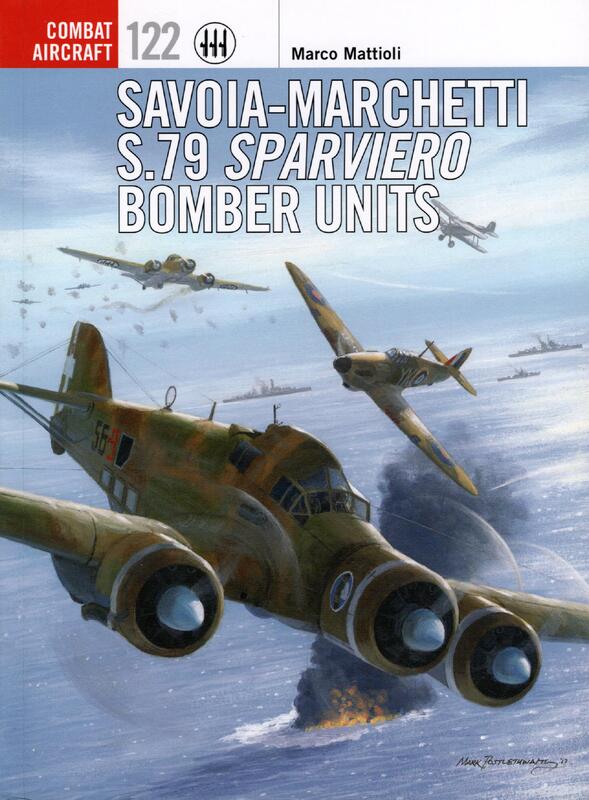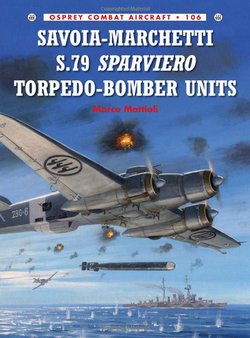Since childhood I have been interested in this sleek-looking Italian trimotor. And I was happy to see that again Mattioli has done a very good job. Again he has been trying to dig out what S.79 Sparvieri actually achieved by checking Italian claims against Allies’ records and clearly states which claims can be verified from Allies’ reports. There are still few overclaimings left but these are minor errors.
p. 11 Spanish battleship Jaime I
After S.79s bombed the ship in Almeria harbour it was according to Spanish Wikipedia able to reach the Cartagena naval base on its own power, not towed there as Mattioli writes.
Silverstone mentions the damage by bombings at Almeria in May 1937 but does not mention how she got to Cartagena. Conway does not even mention the bombings, only the explosion that wrecked Jaime I in June in Cartagena harbour. So I cannot say who is right.
s.57 While in his text Mattioli writes that 11° Stormo S.79s scored the Regia Aeronautica’s first ship ‘kill’ of the war when they damaged destroyer HMS Diamond off Malta on 17 June 1940. On the other hand, this attack is not mentioned in the book’s Appendix A S.79 warship kills 1940-41 -table. According to Naval-history.net HMS Diamond suffered only slightly damage on 11 June 1940 and it makes no mention of June 17. According to en.wikipedia, she was slightly damaged by air attacks near Malta on 11 and 17 June 1940, so its combat capabilities was unlikely to be affected by the damage, so IMHO not even a ship ‘kill’ with quotation marks. Chronik des Seekrieges 1939-1945 does not mention any damage of HMS Diamond on those days. Also, none of the books on my source list mention the possible damage on 17 June.
s. 72 The text states on July 6, 1940 that S.79s ‘were credited with having hit one of the naval vessels’. In fact, British ships have not suffered any damage and correctly nothing is mentioned in the Appendix A.
On the Appendix A, very light damage are included into the table. E.g. battleship HMS Malaya suffered only splinter damage on 8 July 1940 – As it is written in naval-history.net: “During the day, the fleet was under air attacks from a total of 126 high level bombers. In one attack fire control cables were damaged by near misses and repaired.” So only slight damage that was repaired immediately, but the classification is ‘damaged’ in the table.
I checked the table for HMS Ark Royal and HMS Liverpool, for Liverpool it is OK, but for Ark Royal there are IMHO a few trivial matters. For 1 August 1940, Mattioli notes in the text that “shrapnel from the S.79s’ bombs inflicted modest internal damage on Ark Royal.” My other sources do not mention any damage. HMS Ark Royal could launch a planned air attack the following night as planned, so the damage she suffered had no operational impact. In the table, this is marked as “internal damage”, which tells very little about how dangerous/disabling the damage was. IMHO a better damage classification would be (insignificant)?, minor, moderate, heavy etc.
On 9 July 1940 HMS Hood, Resolution and Ark Royal suffered only splinter damage, the table and text say “minor damage”, which is practically the same thing.
On 27 November 1940 HMS Ark Royal suffered again only from near misses, but this time a few of those were very near misses indeed. On the page 157 in Apps’ book there is a sketch map showing the impact points of the misses in relation to the Ark Royal. Some bomb salvos were very close to hitting the ship and a few bombs exploded only appr. 10 yards from her hull. Again in the table damage classification is “internal damage”. This time maybe at least partly meaning damage caused by the mining effect of so near misses.
So only few minor complains.
I was at first puzzled by the captions of two colour profiles (profiles 1, 12) which say that the planes illustrated have a large three-tone camouflage (green, brown and yellow), whereas the drawings themselves show a two-tone band camouflage (brown and yellow). Only after looking at page 46 in Sgarlato’s Italian Aircraft of World War II, which has a small colour plan view of the standard Italian large three-tone band camouflage, although the places of the green and brown are reversed to that in Mattioli’s book and at the b/w photos in this book on pages 19, 24 and 26 I understood that the Italian large three-tone band camouflage shows clearly as a three colour scheme only when viewed from the right or above. But IMHO probably even when viewed from the left, the engine cowlings and the upper parts of the engine nacelles should have been painted with the third colour, in the case of the profiles 1, 2, 5 and 12 green, at least some of them. But I am a total amateur in the Italian camouflage schemes, so this is just an opinion of a total amateur. But any case the lack of any three-way profile drawings is IMHO a shortcoming.
So overall, it's nice to have a book that is based on careful research and contains accurate information about the machine's operations and what it really achieved.
Marco Mattioli’s text gives a brief description of the aircraft’s development and a detailed but clear account of its operational history on all fronts it served. But due to the limited number of pages available, the text sometimes felt a bit too catalogue but there are some short quotes from war diaries of squadriglie, wartime reports and recollections of crew members.
I was surprised that S.79’s active involvement as a bomber ended so early, from 1941, its use decreased significantly and became more marginal towards the end of 1942. It operated as a torpedo bomber still in late 1944 as Mattioli has told in his earlier book, which I have reviewed earlier.
A lot of interesting photos unfortunately many are rather small.
Hopefully Mattioli will also write a book on CANT Z.1007bis in the future.
Apps, Michael, The Four Ark Royals (Abingdon: Purnell 1976).
Dunning, Chris, Combat Units of the Regia Aeronautica Italian Air Force 1940-43. Volume 1(New Malden: Air
Research, 1988).
Gardiner, Robert & Gray, Randal, eds. (1985). Conway's All the World's Fighting Ships, 1906–1921 (London:
Conway Maritime Press, 1985).
Green, William, "Zappata's Wooden Kingfisher". Air International, August 1992, Vol. 43 No. 2, pp. 81–90.
Greene, Jack & Massignani, Alessandro, The Naval War in the Mediterranean 1940 – 1943 (Barnsley:
Frontline Books, 2011).
Playfair, I. S. O. et al., The Mediterranean and Middle East Volume 1: The Early Successes Against Italy, to
May 1941 (London: Her Majesty’s Stationery Office, 1954).
Roskill, S. W. Captain RN, The War at Sea 1939-1945. Volume I. The Defensive (London: Her Majesty’s
Stationery Office, 1954).
Sgarlato, Nico, Italian Aircraft of World War II (Warren, MI: Squadron/Signal, 1979).
Shores, Christopher et.al., Malta: The Hurricane Years. 1940-41 (London: Grub Street, 1987).
Shores, Christopher et.al., A History of the Mediterranean Air War 1940-1945 Volume One (London: Grub
Street, 2012).
Silverstone, Paul H., Directory of the World’s Capital Ships (Shepperton: Ian Allan Ltd., 1984).
https://en.wikipedia.org/wiki/Spanish_battleship_Jaime_I Retrieved on 23 November 2019.
https://es.wikipedia.org/wiki/Jaime_I_(1921) Retrieved on 23 November 2019.
https://www.naval-history.net/xGM-Chrono-10DD-19D-HMS_Diamond.htm Retrieved on 19 August 2019.
https://en.wikipedia.org/wiki/HMS_Diamond_(H22) Retrieved on 19 August 2019.
http://www.naval-history.net/xGM-Chrono-06CL-Capetown.htm [July 6th Carried out bombardment at
Bardia in support of shore military operation] Retrieved on 19 August 2019.
https://www.wlb-stuttgart.de/seekrieg/40-06.htm Retrieved on 19 August 2019.
http://www.wlb-stuttgart.de/seekrieg/40-07.htm Retrieved on 19 August 2019.
https://www.wlb-stuttgart.de/seekrieg/40-11.htm Retrieved on 4 January 2020.
http://www.naval-history.net/xGM-Chrono-06CL-Caledon.htm [bombardment at Bardia not mentioned]
Retrieved on 19 August 2019.
https://www.naval-history.net/xGM-Chrono-01BB-Malaya.htm Retrieved on 19 August 2019.
https://www.naval-history.net/xGM-Chrono-04CV-HMS_Ark_Royal.htm Retrieved on 29 December 2019.
https://en.wikipedia.org/wiki/HMS_Ark_Royal_(91) Retrieved on 29 December 2019.


 RSS Feed
RSS Feed
